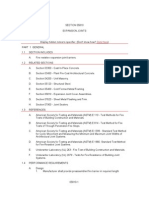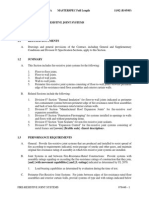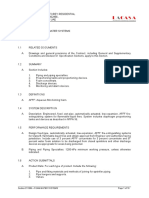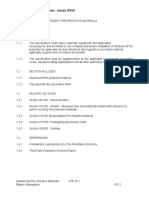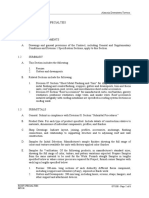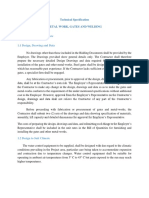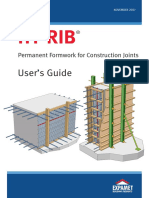Section 078100 - Applied Fireproofing
Section 078100 - Applied Fireproofing
Uploaded by
WENDING HUCopyright:
Available Formats
Section 078100 - Applied Fireproofing
Section 078100 - Applied Fireproofing
Uploaded by
WENDING HUOriginal Title
Copyright
Available Formats
Share this document
Did you find this document useful?
Is this content inappropriate?
Copyright:
Available Formats
Section 078100 - Applied Fireproofing
Section 078100 - Applied Fireproofing
Uploaded by
WENDING HUCopyright:
Available Formats
Alamein Downtown Towers
SECTION 078100 - APPLIED FIREPROOFING
PART 1 - GENERAL
1.1 RELATED DOCUMENTS
A. Drawings and general provisions of the Contract, including General and Supplementary
Conditions and Division 01 Specification Sections, apply to this Section.
1.2 SUMMARY
A. This Section includes the following:
1. Sprayed fire-resistive materials (SFRM).
a. Corrosion resistant protection priming coat that shall be applied to structural
steel surfaces prior to application of the sprayed fire resistive material.
b. Fire resistance protection to any steel surfaces that are protected above or
behind other finish work assemblies similar to furred ceilings, suspended
ceilings, and partitions or lining or applied on exposed steel in back of house
spaces.
c. Other applications as indicated on Drawings where the fire protection material
will be concealed.
B. Related Sections include the following:
1. Division 05 Section "Structural Steel Framing" for surface conditions required for
structural steel receiving SFRM.
2. Division 07 Section "Thermal Insulation"
3. Division 07 Section "Penetration Firestopping" for fire-resistance-rated firestopping
systems.
4. Division 07 Section "Fire-Resistive Joint Systems" for fire-resistance-rated joint
systems.
5. Division 07 Section "Intumescent Mastic Fireproofing".
1.3 DEFINITIONS
A. SFRM: Sprayed fire-resistive material.
B. Concealed: Fire-resistive materials applied to surfaces that are concealed from view behind
other construction when the Work is completed and have not been defined as exposed.
1.4 PERFORMANCE REQUIREMENTS
A. Fire-resistive requirements for building systems and components shall be as shown in Fire
Zoning Drawings and Fire Report.
APPLIED FIREPROOFING 078100 - Page 1 of 13
REV 00
Alamein Downtown Towers
1.5 SUBMITTALS
A. General: Submit in compliance with Division 01 Section “Submittal Procedures.”
B. Product Data: For each type of product indicated.
1. Comply with Division 01 Section "Product Requirements".
C. Shop Drawings: Structural framing plans indicating the following:
1. Locations and types of surface preparations required before applying SFRM.
2. Extent of SFRM for each construction and fire-resistance rating, including the
following:
a. Applicable fire-resistance design designations of a qualified testing and
inspecting agency acceptable to Engineer / authorities having jurisdiction.
b. Minimum thicknesses needed to achieve required fire-resistance ratings of
structural components and assemblies.
3. Treatment of SFRM after application.
D. Product Certificates: For each type of SFRM, signed by product manufacturer.
E. Qualification Data:
1. Qualification data for firms and persons specified in "Quality Assurance" article to
demonstrate their capabilities and experience. Include list of completed projects with
project name, addresses, names of Engineer and Employers, and other information
specified.
2. For Testing Agency Qualifications include proof of qualifications in the form of a
recent report on the inspection of the testing agency by a recognized authority.
F. Compatibility and Adhesion Test Reports: From SFRM manufacturer indicating the
following:
1. Materials have been tested for bond with substrates.
2. Materials have been verified by SFRM manufacturer to be compatible with substrate
primers and coatings.
3. Interpretation of test results and written recommendations for primers and substrate
preparation needed for adhesion.
G. Product Test Reports: Based on evaluation of comprehensive tests performed by a qualified
testing agency, for proposed SFRM. Test report shall include manufacturer name and
contacts in addition to tested product name and detailed description.
H. Field quality-control test and special inspection reports.
I. Warranties: Special warranties specified in this Section.
1.6 LOCAL REGULATIONS AND CODES
A. Comply with applicable requirements of the laws, codes, and regulations of authorities
having jurisdiction.
1. Obtain necessary approvals from authorities having jurisdiction.
APPLIED FIREPROOFING 078100 - Page 2 of 13
REV 00
Alamein Downtown Towers
2. Comply with Egyptian Codes and Standards requirements and latest circulars.
1.7 QUALITY ASSURANCE
A. General: Comply with Division 01 Section “Quality Requirements.”
B. Manufacturer Qualifications: A firm experienced in manufacturing products or systems
similar to those indicated for this Project and with a record of successful in-service
performance, as well as sufficient production capacity to produce required units. As
applicable, procure products from manufacturers able to meet qualification requirements,
warranty requirements, and technical or factory-authorized service representative
requirements. Experience: Minimum of 10 years.
C. Installer Qualifications: A firm or individual certified, licensed, or otherwise qualified by
SFRM manufacturer as experienced and with sufficient trained staff to install manufacturer's
products according to specified requirements. A manufacturer's willingness to sell its
SFRM to Contractor or to an installer engaged by Contractor does not in itself confer
qualification on the buyer. Experience: Minimum of 5 years.
D. Source Limitations: Obtain SFRM through one source from a single manufacturer.
E. SFRM Testing: By a qualified testing and inspecting agency engaged by Contractor or
manufacturer to test for compliance with specified requirements for performance and test
methods.
1. SFRMs are randomly selected for testing from bags bearing the applicable
classification marking of UL or another testing and inspecting agency acceptable to
Engineer / authorities having jurisdiction.
2. Testing is performed on specimens of SFRMs that comply with laboratory testing
requirements specified in Part 2 and are otherwise identical to installed fire-resistive
materials, including application of accelerant, sealers, topcoats, tamping, troweling,
rolling, and water overspray, if any of these are used in final application.
3. Testing is performed on specimens whose application the independent testing and
inspecting agency witnessed during preparation and conditioning. Include in test
reports a full description of preparation and conditioning of laboratory test specimens.
F. Compatibility and Adhesion Testing: Engage a qualified testing and inspecting agency to
test for compliance with requirements for specified performance and test methods.
1. Test for bond per ASTM E 736 and requirements in UL's "Fire Resistance Directory"
for coating materials. Provide bond strength indicated in referenced fire-resistance
design, but not less than minimum specified in Part 2.
2. Verify that manufacturer, through its own laboratory testing or field experience, has
not found primers or coatings to be incompatible with SFRM.
G. Testing Agency Qualifications: An accredited, independent agency with the experience and
capability to conduct testing and inspection indicated, as documented according to
ASTM E329; and, where required by authorities having jurisdiction, that is acceptable to
authorities.
APPLIED FIREPROOFING 078100 - Page 3 of 13
REV 00
Alamein Downtown Towers
H. Fire-Test-Response Characteristics: Provide SFRM with the fire-test-response
characteristics indicated, as determined by testing identical products per test method
indicated below by UL or another testing and inspecting agency acceptable to Engineer /
authorities having jurisdiction. Identify bags containing SFRM with appropriate markings
of applicable testing and inspecting agency.
1. Fire-Resistance Ratings: Indicated by design designations from UL's "Fire
Resistance Directory" or from the listings of another testing and inspecting agency
acceptable to Engineer / authorities having jurisdiction, for SFRM serving as direct-
applied protection tested per ASTM E 119.
2. Surface-Burning Characteristics: ASTM E 84.
I. Provide products containing no detectable asbestos as determined according to the method
specified in 40 CFR 763, Subpart E, Appendix E, Section 1, "Polarized Light Microscopy."
J. Mockups: Apply mockups to verify selections made under sample submittals and to
demonstrate aesthetic effects and set quality standards for materials and execution.
1. Extent of Mockups: Approximately 9 sq. m of surface for each product indicated.
K. Preinstallation Conference: Conduct conference at Project site to comply with requirements
in Division 01 Section "Project Management and Coordination." Review methods and
procedures related to SFRM including, but not limited to, the following:
1. Review products, exposure conditions, design ratings, restrained and unrestrained
conditions, calculations, densities, thicknesses, bond strengths, and other performance
requirements.
2. Review and finalize construction schedule and verify sequencing and coordination
requirements.
3. Review weather predictions, ambient conditions, and proposed temporary protections
for SFRM during and after installation.
4. Review surface conditions and preparations.
5. Review field quality-control testing procedures.
1.8 DELIVERY, STORAGE, AND HANDLING
A. Deliver products to Project site in original, unopened packages with intact and legible
manufacturers' labels identifying product and manufacturer, date of manufacture, shelf life if
applicable, and fire-resistance ratings applicable to Project.
B. Use materials with limited shelf life within period indicated. Remove from Project site and
discard materials whose shelf life has expired.
C. Store materials inside, under cover, and aboveground; keep dry until ready for use. Remove
from Project site and discard wet or deteriorated materials.
1.9 PROJECT CONDITIONS
A. Environmental Limitations: Do not apply SFRM when ambient or substrate temperature is
4 deg C or lower unless temporary protection and heat are provided to maintain temperature
at or above this level for 24 hours before, during, and for 24 hours after product application.
APPLIED FIREPROOFING 078100 - Page 4 of 13
REV 00
Alamein Downtown Towers
B. Ventilation: Ventilate building spaces during and after application of SFRM. Use natural
means or, if they are inadequate, forced-air circulation until fire-resistive material dries
thoroughly.
1.10 COORDINATION
A. Sequence and coordinate application of SFRM with other related work specified in other
Sections to comply with the following requirements:
1. Provide temporary enclosure as required to confine spraying operations and protect
the environment.
2. Provide temporary enclosures for applications to prevent deterioration of fire-resistive
material due to exposure to weather and to unfavorable ambient conditions for
humidity, temperature, and ventilation.
3. Avoid unnecessary exposure of fire-resistive material to abrasion and other damage
likely to occur during construction operations subsequent to its application.
4. Do not apply fire-resistive material to metal roof deck substrates until concrete
topping, if any, has been completed. For metal roof decks without concrete topping,
do not apply fire-resistive material to metal roof deck substrates until roofing has
been completed; prohibit roof traffic during application and drying of fire-resistive
material.
5. Do not apply fire-resistive material to metal floor deck substrates until concrete
topping has been completed.
6. Do not begin applying fire-resistive material until clips, hangers, supports, sleeves,
and other items penetrating fire protection are in place.
7. Defer installing ducts, piping, and other items that would interfere with applying fire-
resistive material until application of fire protection is completed.
8. Do not install enclosing or concealing construction until after fire-resistive material
has been applied, inspected, and tested and corrections have been made to defective
applications.
1.11 WARRANTY
A. Comply with Division 01 Section "Warranties".
B. Special Warranty: Manufacturer's standard form, signed by Contractor and by Installer, in
which manufacturer agrees to repair or replace SFRMs that fail in materials or workmanship
within specified warranty period.
1. Failures include, but are not limited to, the following:
a. Cracking, flaking, spalling, or eroding in excess of specified requirements;
peeling; or delaminating of SFRM from substrates.
b. Not covered under the warranty are failures due to damage by occupants and
Employer's maintenance personnel, exposure to environmental conditions other
than those investigated and approved during fire-response testing, and other
causes not reasonably foreseeable under conditions of normal use.
2. Warranty Period: Ten years from date of Substantial Completion.
APPLIED FIREPROOFING 078100 - Page 5 of 13
REV 00
Alamein Downtown Towers
C. Special Warranty for Sprayed Fire-Resistive Materials Corrosion Protection Performance:
Manufacturer's standard form signed by the Contractor and by the Installer, in which
manufacturer agrees to repair or replace steel priming protection coat that fail to provide
corrosion protection to structural steel of 20 years to first maintenance.
PART 2 - PRODUCTS
2.1 SPRAYED FIRE RESISTIVE SYSTEM
A. Comply with the following:
1. Surface preparation as specified in Division 5, Section “Structural Steel Framing”.
2. Epoxy-zinc-rich primer in number and thickness of coats to satisfy the warranty
period to first maintenance as specified.
a. Corrosion-Protection Prime Coat: Factory-formulated epoxy zinc-rich steel
primer to SSPC-Paint 20 applied at spreading rate recommended by
intumescent paint manufacturer.
1) Primer coat shall comply with ISO 12944 all parts generally and ISO
12944-5 specifically for Corrosivity Category C3, High Durability.
2) Primer shall be warranted by manufacturer as providing corrosion
protection to first maintenance of not less than 20 years.
3) Primer's bond strength complies with requirements specified in UL's
"Fire Resistance Directory" for coating materials based on a series of
bond tests per ASTM E 736.
4) Primer is identical to those used in assemblies tested for fire-test-
response characteristics of SFRM per ASTM E 119 by UL or another
testing and inspecting agency acceptable to Engineer / authorities having
jurisdiction.
5) Volume Solids: Not less than 70% ± 3, with high zinc content in the dry
film.
6) Shall be applicable in not less than of the specified minimum thickness
of 80 microns.
a) Corrosion protection primer shall be applied in the factory.
b) Application: Airless Spray.
3. Adhesive for bonding fire-resistive material certified as compatible with the applied
primer.
4. SFRM in thickness required to obtain the indicated fire resistance rating for each
structural steel section based on the ratio Hp/A of the section and the loading tables
(coating thickness tables) certified by the third party testing agency which accredited
the fire rating of the SFRM product.
5. Two sealer coats where the SFRM is used within a ceiling air plenum.
6. Two acrylic coats where the SFRM is used within a ceiling maintenance plenum or
where shown on Drawings or directed by Engineer.
a. Color: As selected by Engineer.
B. Features:
1. Cementitious, durable, remains in place during construction and beyond.
APPLIED FIREPROOFING 078100 - Page 6 of 13
REV 00
Alamein Downtown Towers
2. Film build-on all surfaces including columns, beams and decks.
3. Applicator friendly, high film build, no alum required for increased coverage and
easy clean-up.
4. Asbestos-free, complies with EPA and OSHA regulations.
5. Mineral-wool free, no airborne fibers.
6. Alum and chloride free, no special priming required.
7. Styrene free, no toxic decomposition gasses.
8. Multiple UL designs, provides for design flexibility with over 40 UL designs.
9. Quality Manufactured, under strict quality standards.
10. UL inspection service, consistent quality in every bag.
11. Ready to use, no site additives required.
2.2 SPRAYED FIRE-RESISTIVE MATERIALS (SFRM)
A. Available Manufacturer: Subject to compliance with requirements, manufacturer that may
be incorporated into the Work include, but are not limited to, the following:
1. Concealed Cementitious SFRM:
a. Carboline Co., Fireproofing Products Div.
b. GCP Applied Technologies Inc. (formerly Grace Construction Products).
c. Isolatek International Corp.
B. Material Composition: Manufacturer's standard product, as follows:
1. Factory-mixed, dry formulation of gypsum or portland cement binders, additives, and
lightweight mineral or synthetic aggregates mixed with water at Project site to form a
slurry or mortar for conveyance and application.
C. Low Density Physical Properties: Minimum values, unless otherwise indicated, or higher
values required to attain designated fire-resistance ratings, measured per standard test
methods referenced with each property as follows:
1. Use for a building height up to 22.8 m above the lowest level of fire department
vehicle access as per IBC requirements.
2. Dry Density: 240 kg/cu. m for average and individual densities, or greater if required
to attain fire-resistance ratings indicated, per ASTM E 605 or AWCI Technical
Manual 12-A, Section 5.4.5, "Displacement Method."
3. Thickness: As required for fire-resistance design indicated, measured according to
requirements of fire-resistance design or ASTM E605, whichever is thicker, but not
less than 0.375 inch (9 mm).
4. Bond Strength: 16 kPa minimum per ASTM E 736 based on laboratory testing of 19-
mm minimum thickness of SFRM.
5. Compressive Strength: 65 kPa minimum per ASTM E 761. Minimum thickness of
SFRM tested shall be 19 mm and minimum dry density shall be as specified but not
less than 240 kg/cu. m.
6. Corrosion Resistance: No evidence of corrosion per ASTM E 937.
7. Deflection: No cracking, spalling, or delamination per ASTM E 759.
8. Effect of Impact on Bonding: No cracking, spalling, or delamination per
ASTM E 760.
9. Air Erosion: Maximum weight loss of 0.000 g/sq. m in 24 hours per ASTM E 859.
For laboratory tests, minimum thickness of SFRM is 19 mm, maximum dry density is
240 kg/cu. m, test specimens are not prepurged by mechanically induced air
velocities, and tests are terminated after 24 hours.
APPLIED FIREPROOFING 078100 - Page 7 of 13
REV 00
Alamein Downtown Towers
10. Fire-Test-Response Characteristics: Provide SFRM with the following surface-
burning characteristics as determined by testing identical products per ASTM E 84 by
UL or another testing and inspecting agency acceptable to Engineer / authorities
having jurisdiction:
a. Flame-Spread Index: 10 or less.
b. Smoke-Developed Index: 0.
11. Fungal Resistance: No observed growth on specimens per ASTM G 21.
D. Medium Density Physical Properties: Minimum values, unless otherwise indicated, or
higher values required to attain designated fire-resistance ratings, measured per standard test
methods referenced with each property as follows:
1. Use for a building height above 22.8 m as per IBC requirements.
2. Dry Density: 350 kg/cu. m for average and individual densities, or greater if required
to attain fire-resistance ratings indicated, per ASTM E 605 or AWCI Technical
Manual 12-A, Section 5.4.5, "Displacement Method."
3. Thickness: As required for fire-resistance design indicated, measured according to
requirements of fire-resistance design or ASTM E605, whichever is thicker, but not
less than 0.375 inch (9 mm).
4. Bond Strength: 90 kPa minimum per ASTM E 736 based on laboratory testing.
5. Compressive Strength: 650 kPa minimum per ASTM E 761.
6. Corrosion Resistance: No evidence of corrosion per ASTM E 937.
7. Deflection: No cracking, spalling, or delamination per ASTM E 759.
8. Effect of Impact on Bonding: No cracking, spalling, or delamination per
ASTM E 760.
9. Air Erosion: Maximum weight loss of 0.000 g/sq. m in 24 hours per ASTM E 859.
For laboratory tests, minimum thickness of SFRM is 19 mm, test specimens are not
prepurged by mechanically induced air velocities, and tests are terminated after 24
hours.
10. Fire-Test-Response Characteristics: Provide SFRM with the following surface-
burning characteristics as determined by testing identical products per ASTM E 84 by
UL or another testing and inspecting agency acceptable to Engineer / authorities
having jurisdiction:
a. Flame-Spread Index: 10 or less.
b. Smoke-Developed Index: 0.
11. Fungal Resistance: No observed growth on specimens per ASTM G 21.
E. High Density Physical Properties: Minimum values, unless otherwise indicated, or higher
values required to attain designated fire-resistance ratings, measured per standard test
methods referenced with each property as follows:
1. Use for smooth leveled finished SFRM that are ready to accept paint finishing
directly for exposed applications indicated on Drawings or selected by Engineer.
2. Dry Density: 640 kg/cu. m for average and individual densities, or greater if required
to attain fire-resistance ratings indicated, per ASTM E 605 or AWCI Technical
Manual 12-A, Section 5.4.5, "Displacement Method."
3. Thickness: As required for fire-resistance design indicated, measured according to
requirements of fire-resistance design or ASTM E605, whichever is thicker, but not
less than 0.375 inch (9 mm).
4. Bond Strength: 700-kPa minimum per ASTM E 736 based on laboratory testing.
5. Compressive Strength: 3500 kPa minimum per ASTM E 761.
APPLIED FIREPROOFING 078100 - Page 8 of 13
REV 00
Alamein Downtown Towers
6. Corrosion Resistance: No evidence of corrosion per ASTM E 937.
7. Deflection: No cracking, spalling, or delamination per ASTM E 759.
8. Effect of Impact on Bonding: No cracking, spalling, or delamination per
ASTM E 760.
9. Air Erosion: Maximum weight loss of 0.000 g/sq. m in 24 hours per ASTM E 859.
For laboratory tests, minimum thickness of SFRM is 19 mm, test specimens are not
prepurged by mechanically induced air velocities, and tests are terminated after 24
hours.
10. Fire-Test-Response Characteristics: Provide SFRM with the following surface-
burning characteristics as determined by testing identical products per ASTM E 84 by
UL or another testing and inspecting agency acceptable to Engineer / authorities
having jurisdiction:
a. Flame-Spread Index: 10 or less.
b. Smoke-Developed Index: 0.
11. Fungal Resistance: No observed growth on specimens per ASTM G 21.
2.3 AUXILIARY FIRE-RESISTIVE MATERIALS
A. General: Provide auxiliary fire-resistive materials that are compatible with SFRM and
substrates and are approved by UL or another testing and inspecting agency acceptable to
Engineer / authorities having jurisdiction for use in fire-resistance designs indicated.
B. Structural steel, whether interior or exterior shall receive an anti-corrosive primer coating, as
per structural steel specifications prior to the application of spray applied fireproofing. The
application of the anti-corrosive primer to protect the underlying structural steel shall be as
per the recommendations in the UL Fire Resistance Directory and may require the use of
bonding agents or mechanical attachment on beams, columns, tube and pipe steel to
maintain the fire-resistive rating. Obtain the certification of the coating supplier that the
primer is fully compatible with portland cement based fireproofing. An on-site mock-up and
bond test shall be performed on all unknown or untested coatings prior to application of
fireproofing to determine compatibility.
1. Primers based on chlorinated rubber, bitumen or solvent born thermoplastics should
not be used because of their softening in case of fire.
C. Adhesive for Bonding Fire-Resistive Material: Product approved by manufacturer of
SFRM.
D. Metal Lath: Expanded metal lath fabricated from material of weight, configuration, and
finish required to comply with fire-resistance designs indicated and fire-resistive material
manufacturer's written recommendations. Include clips, lathing accessories, corner beads,
and other anchorage devices required to attach lath to substrates and to receive SFRM.
E. Reinforcing Fabric: Glass- or carbon-fiber fabric of type, weight, and form required to
comply with fire-resistance designs indicated; approved and provided by manufacturer of
SFRM.
F. Reinforcing Mesh: Metallic mesh reinforcement of type, weight, and form required to
comply with fire-resistance designs indicated; approved and provided by manufacturer of
intumescent mastic coating fire-resistive material. Include pins and attachment.
APPLIED FIREPROOFING 078100 - Page 9 of 13
REV 00
Alamein Downtown Towers
G. Sealer for Sprayed-Fiber Fire-Resistive Material: Transparent-drying, water-dispersible,
tinted protective coating recommended in writing by manufacturer of sprayed-fiber fire-
resistive material.
H. Topcoat: Type recommended in writing by manufacturer of each SFRM for application over
concealed SFRM.
I. Cement-Based Topcoat: Factory-mixed, cementitious hardcoat formulation recommended in
writing by manufacturer of SFRM for trowel or spray application over concealed SFRM.
PART 3 - EXECUTION
3.1 EXAMINATION
A. Examine substrates, areas, and conditions, with Installer present, for compliance with
requirements for substrates and other conditions affecting performance of work. A substrate
is in satisfactory condition if it complies with the following:
1. Substrates comply with requirements in the Section where the substrate and related
materials and construction are specified.
2. Substrates are free of dirt, oil, grease, release agents, rolling compounds, mill scale,
loose scale, incompatible primers, incompatible paints, incompatible encapsulants, or
other foreign substances capable of impairing bond of fire-resistive materials with
substrates under conditions of normal use or fire exposure.
3. Objects penetrating fire-resistive material, including clips, hangers, support sleeves,
and similar items, are securely attached to substrates.
4. Substrates are not obstructed by ducts, piping, equipment, and other suspended
construction that will interfere with applying fire-resistive material.
B. Verify that concrete work on steel deck has been completed.
C. Verify that roof construction, installation of roof-top HVAC equipment, and other related
work are completed.
D. Conduct tests according to fire-resistive material manufacturer's written recommendations to
verify that substrates are free of substances capable of interfering with bond.
E. Proceed with installation only after unsatisfactory conditions have been corrected.
3.2 PREPARATION
A. Cover other work subject to damage from fallout or overspray of fire-resistive materials
during application.
B. Cleaning: Before applying coatings or other surface treatments, clean substrates of
substances that could impair bond of the fire-resistive material.
1. Schedule cleaning and painting application so dust and other contaminants will not
fall on wet, newly painted surfaces.
APPLIED FIREPROOFING 078100 - Page 10 of 13
REV 00
Alamein Downtown Towers
2. Clean and prepare surfaces to be painted according to manufacturer's written
instructions for each particular substrate condition and as specified:
a. Prior to applying primer the steel surfaces shall be blast cleaned to SA 2½ (ISO
8501-1).
C. Prime substrates where recommended in writing by SFRM manufacturer unless compatible
shop primer has been applied and is in satisfactory condition to receive SFRM.
3.3 APPLICATION, GENERAL
A. Comply with fire-resistive material manufacturer's written instructions for mixing materials,
application procedures, and types of equipment used to mix, convey, and spray on fire-
resistive material, as applicable to particular conditions of installation and as required to
achieve fire-resistance ratings indicated.
B. Apply SFRM that is identical to products tested as specified in Part 1 "Quality Assurance"
Article and substantiated by test reports, with respect to rate of application, accelerator use,
sealers, topcoats, tamping, troweling, water overspray, or other materials and procedures
affecting test results.
C. Install metal lath and reinforcing fabric, as required, to comply with fire-resistance ratings
and fire-resistive material manufacturer's written recommendations for conditions of
exposure and intended use. Securely attach lath and fabric to substrate in position required
for support and reinforcement of fire-resistive material. Use anchorage devices of type
recommended in writing by SFRM manufacturer. Attach accessories where indicated or
required for secure attachment of lath and fabric to substrate.
D. Coat substrates with bonding adhesive before applying fire-resistive material where required
to achieve fire-resistance rating or as recommended in writing by SFRM manufacturer for
material and application indicated.
E. Extend fire-resistive material in full thickness over entire area of each substrate to be
protected. Unless otherwise recommended in writing by SFRM manufacturer, install body
of fire-resistive covering in a single course.
F. Spray apply fire-resistive materials to maximum extent possible. Following the spraying
operation in each area, complete the coverage by trowel application or other placement
method recommended in writing by SFRM manufacturer.
G. For applications over encapsulant materials, including lockdown (post-removal)
encapsulants, apply SFRM that differs in color from that of encapsulant over which it is
applied.
H. Where sealers are used, apply products that are tinted to differentiate them from SFRM over
which they are applied.
3.4 APPLICATION, CONCEALED SFRM
A. Apply concealed SFRM in thicknesses and densities not less than those required to achieve
fire-resistance ratings designated for each condition, but apply in greater thicknesses and
densities if specified in Part 2.
APPLIED FIREPROOFING 078100 - Page 11 of 13
REV 00
Alamein Downtown Towers
B. Cure concealed SFRM according to product manufacturer's written recommendations.
3.5 APPLICATION, EXPOSED SFRM
A. Apply exposed SFRM in thicknesses and densities not less than those required to achieve
fire-resistance ratings designated for each condition, but apply in greater thicknesses and
densities if indicated.
B. Provide a uniform finish complying with description indicated for each type of material and
matching Engineer's sample or, if none, finish approved for field-erected mockup.
C. Apply exposed cementitious SFRM to produce the following finish:
1. Smooth, troweled finish with surface markings eliminated and edges squared.
D. Cure exposed SFRM according to product manufacturer's written recommendations.
3.6 FIELD QUALITY CONTROL
A. Special Inspections: Engage a qualified special inspector to perform the following special
inspection and prepare reports:
1. SFRM.
B. Testing Agency: Engage a qualified testing agency to perform tests and inspections and
prepare test reports.
1. Testing and inspecting agency will interpret tests and state in each report whether
tested work complies with or deviates from requirements.
C. Tests and Inspections: Testing and inspecting of completed applications of SFRM shall take
place in successive stages, in areas of extent and using methods as follows. Do not proceed
with application of SFRM for the next area until test results for previously completed
applications of SFRM show compliance with requirements. Tested values must equal or
exceed values indicated and required for approved fire-resistance design.
1. Thickness for Floor, Roof, and Wall Assemblies: For each 93-sq. m area, or partial
area, on each floor, from the average of 4 measurements from a 0.093-sq. m sample
area, with sample width of not less than 152 mm per ASTM E 605.
2. Thickness for Structural Frame Members: From a sample of 25 percent of structural
members per floor, taking 9 measurements at a single cross section for structural
frame beams or girders, 7 measurements of a single cross section for joists and
trusses, and 12 measurements of a single cross section for columns per ASTM E 605.
3. Density for Floors, Roofs, Walls, and Structural Frame Members: At frequency and
from sample size indicated for determining thickness of each type of construction and
structural framing member, per ASTM E 605 or AWCI Technical Manual 12-A,
Section 5.4.5, "Displacement Method."
APPLIED FIREPROOFING 078100 - Page 12 of 13
REV 00
Alamein Downtown Towers
4. Bond Strength for Floors, Roofs, Walls, and Structural Framing Members: For each
929 sq. m area, or partial area, on each floor, cohesion and adhesion from one sample
of size indicated for determining thickness of each type of construction and structural
framing member, per ASTM E 736.
a. Field test SFRM that is applied to flanges of wide-flange, structural-steel
members on surfaces matching those that will exist for remainder of steel
receiving fire-resistive material.
b. If surfaces of structural steel receiving SFRM are primed or otherwise painted
for coating materials, perform series of bond tests specified in UL's "Fire
Resistance Directory." Provide bond strength indicated in referenced UL fire-
resistance criteria.
5. If testing finds applications of SFRM are not in compliance with requirements, testing
and inspecting agency will perform additional random testing to determine extent of
noncompliance.
D. Remove and replace applications of SFRM that do not pass tests and inspections for
cohesion and adhesion, for density, or for both and retest as specified above.
E. Apply additional SFRM, per manufacturer's written instructions, where test results indicate
that thickness does not comply with specified requirements, and retest as specified above.
3.7 CLEANING, PROTECTING, AND REPAIR
A. Cleaning: Immediately after completing spraying operations in each containable area of
Project, remove material overspray and fallout from surfaces of other construction and clean
exposed surfaces to remove evidence of soiling.
B. Protect SFRM, according to advice of product manufacturer and Installer, from damage
resulting from construction operations or other causes so fire protection will be without
damage or deterioration at time of Substantial Completion.
C. Coordinate application of SFRM with other construction to minimize need to cut or remove
fire protection. As installation of other construction proceeds, inspect SFRM and patch any
damaged or removed areas.
D. Repair or replace work that has not successfully protected steel.
END OF SECTION 078100
APPLIED FIREPROOFING 078100 - Page 13 of 13
REV 00
You might also like
- Div 078100 Applied FireproofingDocument8 pagesDiv 078100 Applied FireproofingrobinhossNo ratings yet
- SECTION 09 96 00 High Performance Coatings GeneralDocument8 pagesSECTION 09 96 00 High Performance Coatings Generalraja qammarNo ratings yet
- SECTION 07 8123 Intumescent Fireproofing Part 1 General 1.01 Section IncludesDocument4 pagesSECTION 07 8123 Intumescent Fireproofing Part 1 General 1.01 Section IncludesStephen KokoNo ratings yet
- CAFCO High Density SFRM SpecDocument10 pagesCAFCO High Density SFRM Specselva.uae8207No ratings yet
- Louis Sullivan - Ornament in Architecture (1892)Document4 pagesLouis Sullivan - Ornament in Architecture (1892)Akiles Garcia Arias100% (1)
- The Limited City - Building Height Regulations in The City of Melbourne, 1890-1955 by Peter Mills 1997Document75 pagesThe Limited City - Building Height Regulations in The City of Melbourne, 1890-1955 by Peter Mills 1997tismdblNo ratings yet
- And Machine Rooms) (, That Are in Mechanical Rooms) (, That Are in Air-Handling Plenums)Document13 pagesAnd Machine Rooms) (, That Are in Mechanical Rooms) (, That Are in Air-Handling Plenums)Emiliano Grados BarreraNo ratings yet
- Section 077129 - Manufactured Roof Expansion JointsDocument6 pagesSection 077129 - Manufactured Roof Expansion JointsWENDING HUNo ratings yet
- CAFCO-All-Products-Spec-Dual-Branding-Update-10-19Document12 pagesCAFCO-All-Products-Spec-Dual-Branding-Update-10-19Marcelo AlvesNo ratings yet
- Division 083344 - OVERHEAD COILING FIRE CURTAINSDocument6 pagesDivision 083344 - OVERHEAD COILING FIRE CURTAINSmohamedifasNo ratings yet
- Penetration-Fire StoppingDocument8 pagesPenetration-Fire StoppingTaher AmmarNo ratings yet
- V00 (Penetration Firestopping)Document8 pagesV00 (Penetration Firestopping)buzzpavanNo ratings yet
- Click HereDocument5 pagesClick HereGirish ReesaulNo ratings yet
- Section 078200 - Board FireproofingDocument5 pagesSection 078200 - Board FireproofingWENDING HUNo ratings yet
- 07 84 13 Penetration FirestoppingDocument8 pages07 84 13 Penetration FirestoppingSoumojit SamantaNo ratings yet
- 078100-Spray-Applied-Fireproofing-Specification - Monokote MK-6Document7 pages078100-Spray-Applied-Fireproofing-Specification - Monokote MK-6Ralph Ian MalabananNo ratings yet
- Carboline Southwest SFRM Specification 11-11-10Document8 pagesCarboline Southwest SFRM Specification 11-11-10Salman ShaikhNo ratings yet
- Firestopping - AMCSI Specification - 00Document11 pagesFirestopping - AMCSI Specification - 00VINOD PAULNo ratings yet
- Specification Section 07810 Interior Cementitious Spray - Applied FireproofingDocument10 pagesSpecification Section 07810 Interior Cementitious Spray - Applied FireproofingMouayed ZeadanNo ratings yet
- Fire PumpsDocument25 pagesFire Pumpsfarshan296015No ratings yet
- SECTION 07 81 00 Applied FireproofingDocument10 pagesSECTION 07 81 00 Applied FireproofingJuanPaoloYbañezNo ratings yet
- SECTION 07531 Elastomeric Sheet RoofingDocument8 pagesSECTION 07531 Elastomeric Sheet RoofingIm ChinithNo ratings yet
- Spec Section 23 00 00 For Firestopping For HVACDocument9 pagesSpec Section 23 00 00 For Firestopping For HVACblahblahNo ratings yet
- Spec Section 15084 For Firestopping For MechanicalDocument7 pagesSpec Section 15084 For Firestopping For MechanicalblahblahNo ratings yet
- Specification Text ASSET DOC LOC 1619186Document9 pagesSpecification Text ASSET DOC LOC 1619186Santiago BNo ratings yet
- Section 07810 Applied FireproofingDocument4 pagesSection 07810 Applied FireproofingMØhãmmed ØwięsNo ratings yet
- Section 12494 Roller ShadesDocument5 pagesSection 12494 Roller ShadesMØhãmmed ØwięsNo ratings yet
- Section 14 - Roofing Part 2 - Membrane Roofing 2.5 Modified Bitumen Membrane RoofingDocument9 pagesSection 14 - Roofing Part 2 - Membrane Roofing 2.5 Modified Bitumen Membrane RoofingNATHANNo ratings yet
- FIRESTOPPINGDocument6 pagesFIRESTOPPINGstopitssmithingtimeNo ratings yet
- High PerformanceDocument12 pagesHigh PerformanceAhmed hafezNo ratings yet
- SSH/14040/Main Contract Works 099600 / 1 Document III High-Performance CoatingsDocument14 pagesSSH/14040/Main Contract Works 099600 / 1 Document III High-Performance CoatingsHussain GodhrawalaNo ratings yet
- 078123-RIB-Intumescent Fire Protection KSA ASP 240131Document3 pages078123-RIB-Intumescent Fire Protection KSA ASP 240131Osama KheadryNo ratings yet
- Section 07840Document9 pagesSection 07840Im ChinithNo ratings yet
- Southwest Type 5GP Technical Specification GuideDocument2 pagesSouthwest Type 5GP Technical Specification GuideTanmay GorNo ratings yet
- Fireresistivejointsystems DFMmetricizedversioDocument8 pagesFireresistivejointsystems DFMmetricizedversioReza KhajeNo ratings yet
- Spec Section 07-84-00 For Firestopping Specification Text ASSET DOC LOC 1619205Document13 pagesSpec Section 07-84-00 For Firestopping Specification Text ASSET DOC LOC 1619205Ahmed OmarNo ratings yet
- Spec 079219 - Acoustical Joint SealantsDocument5 pagesSpec 079219 - Acoustical Joint Sealantsداروین پرزNo ratings yet
- Pyrolite 15 Technical Specification Guide PDFDocument3 pagesPyrolite 15 Technical Specification Guide PDFTanmay Gor100% (1)
- SECTION 07 84 00 FirestoppingDocument6 pagesSECTION 07 84 00 FirestoppingJuanPaoloYbañezNo ratings yet
- Penetration FirestoppingDocument8 pagesPenetration FirestoppinginstrengNo ratings yet
- H41Document13 pagesH41alan_jalil9365No ratings yet
- 23 07 13 Duct InsulationDocument11 pages23 07 13 Duct InsulationSaif SaadNo ratings yet
- Clean AgentDocument11 pagesClean Agentfarshan296015No ratings yet
- Section 07920 Joint SealantsDocument7 pagesSection 07920 Joint SealantsMØhãmmed ØwięsNo ratings yet
- Specification Text ASSET DOC LOC 1619176Document12 pagesSpecification Text ASSET DOC LOC 1619176KarlaMarlenNo ratings yet
- Aluminum WindowsDocument14 pagesAluminum Windowshayat49000No ratings yet
- HydroStop System Spec PDFDocument21 pagesHydroStop System Spec PDFRafaelNo ratings yet
- Foam-Water SystemsDocument10 pagesFoam-Water SystemsAlaa FouaniNo ratings yet
- Acousti-Seal Premier Electric (933E) Technical DataDocument18 pagesAcousti-Seal Premier Electric (933E) Technical Datamohammed yousufNo ratings yet
- Section 230713 - Duct InsulationDocument7 pagesSection 230713 - Duct Insulationmattar2007No ratings yet
- DC 315 Master SpecificationDocument6 pagesDC 315 Master SpecificationYusuf AhmedNo ratings yet
- Insulation SpecsDocument13 pagesInsulation SpecsMuhammad GoudaNo ratings yet
- ISOLATEK Intumescent Interior Spec April 2015 2Document6 pagesISOLATEK Intumescent Interior Spec April 2015 2FALwilliamsNo ratings yet
- Metal Framed SkylightsDocument13 pagesMetal Framed SkylightsLloyd R. PonceNo ratings yet
- Fire Protective CoatingsDocument15 pagesFire Protective CoatingsMohamed AAmerNo ratings yet
- SpecsDocument6 pagesSpecsTAHANINo ratings yet
- Metal Roofing Master SpecificationDocument11 pagesMetal Roofing Master Specificationnick.lee0602No ratings yet
- 26 51 19 - LED Interior Lighting ApprovedDocument12 pages26 51 19 - LED Interior Lighting ApprovedalasfarmohamedsaadNo ratings yet
- Spec For Hvac Fire Rated Duct InsulationDocument8 pagesSpec For Hvac Fire Rated Duct InsulationPradeep SukumaranNo ratings yet
- Project SpecDocument5 pagesProject SpecCyril J PadiyathNo ratings yet
- Residential Asphalt Roofing Manual Design and Application Methods 2014 EditionFrom EverandResidential Asphalt Roofing Manual Design and Application Methods 2014 EditionNo ratings yet
- Hand Book For Steel Structure Quality Control on SiteFrom EverandHand Book For Steel Structure Quality Control on SiteNo ratings yet
- Section 078200 - Board FireproofingDocument5 pagesSection 078200 - Board FireproofingWENDING HUNo ratings yet
- Section 078123 - Intumescent Mastic FireproofingDocument11 pagesSection 078123 - Intumescent Mastic FireproofingWENDING HUNo ratings yet
- Section 077100 - Roof SpecialtiesDocument6 pagesSection 077100 - Roof SpecialtiesWENDING HUNo ratings yet
- Section 067300 - Composite DeckingDocument4 pagesSection 067300 - Composite DeckingWENDING HUNo ratings yet
- Section 055000 - Metal FabricationsDocument15 pagesSection 055000 - Metal FabricationsWENDING HUNo ratings yet
- Section 035440 - Cement-Based ScreedDocument11 pagesSection 035440 - Cement-Based ScreedWENDING HUNo ratings yet
- Section 034501 - Miscellaneous Architectural Precast ConcreteDocument6 pagesSection 034501 - Miscellaneous Architectural Precast ConcreteWENDING HUNo ratings yet
- ShaliCure AcrylateDocument2 pagesShaliCure AcrylateSunil Kumar GiriNo ratings yet
- Cycling VelodromeDocument4 pagesCycling VelodromemahakNo ratings yet
- Scaffolding Methodology-Skyrise 3A - 1Document5 pagesScaffolding Methodology-Skyrise 3A - 1AdonisNo ratings yet
- Annex-1 Technical Specification-GatesDocument9 pagesAnnex-1 Technical Specification-GatesShyam Raj JillaNo ratings yet
- Design of Steel Beams To AISC - LRFDDocument52 pagesDesign of Steel Beams To AISC - LRFDsony setyawan100% (1)
- Igc 2-1 Work Place Hazards and Risk ControlDocument142 pagesIgc 2-1 Work Place Hazards and Risk ControlRamiz SelmaniNo ratings yet
- Moren - MODULE 5 - Eccentric ConnectionsDocument13 pagesMoren - MODULE 5 - Eccentric ConnectionsJoshua Espanto MorenNo ratings yet
- Project: Conti'S Bakeshop & Restaurant - SM Bacoor: LOCATION: Unit 134, Upper Ground Floor, SM City Bacoor, CaviteDocument1 pageProject: Conti'S Bakeshop & Restaurant - SM Bacoor: LOCATION: Unit 134, Upper Ground Floor, SM City Bacoor, CaviteAndrew Paul BatacNo ratings yet
- Tanda - NDCT TenderDocument7 pagesTanda - NDCT TenderPravin AwalkondeNo ratings yet
- MEP SpecificationDocument283 pagesMEP SpecificationMohd Salleh Zainal100% (2)
- SG32 17 Provision of Extended and Telescopic Transoms and Board Brackets 1Document12 pagesSG32 17 Provision of Extended and Telescopic Transoms and Board Brackets 1Nizar MohamedNo ratings yet
- AD 406 - Transient Response Factors in Vibration Analysis of Staircases, April 2017Document1 pageAD 406 - Transient Response Factors in Vibration Analysis of Staircases, April 2017symon ellimacNo ratings yet
- Hy-Rib Permanet Formwork - TDSDocument20 pagesHy-Rib Permanet Formwork - TDSKRISHNA PRASATH SNo ratings yet
- Night Journey (Yorushika) - Saku Guitar TabDocument7 pagesNight Journey (Yorushika) - Saku Guitar TabIncognito OBoneNo ratings yet
- Aohg30lat4 enDocument112 pagesAohg30lat4 enTomás ArrebolaNo ratings yet
- Pocketguide To Construction SafetyDocument44 pagesPocketguide To Construction SafetyAbdalrahman al-neimat100% (1)
- Building Envelope TestingDocument25 pagesBuilding Envelope TestingAisha SajidNo ratings yet
- Sateba M312 Sleeper Data SheetDocument2 pagesSateba M312 Sleeper Data SheetToni Garrote FerreroNo ratings yet
- Million Palace Construction & Engineering Company Q06072024Document3 pagesMillion Palace Construction & Engineering Company Q06072024nyanhtunlimNo ratings yet
- Carta de Presentacion Sin-1Document1 pageCarta de Presentacion Sin-1SebastiianMorenoChNo ratings yet
- Gradation Chart: Sieve Analysis of Fine AggregateDocument31 pagesGradation Chart: Sieve Analysis of Fine AggregateSrinivas RegulavalasaNo ratings yet
- Application of Discrete Galvanic Anode Using Sika FerroGard-700s RebaDocument10 pagesApplication of Discrete Galvanic Anode Using Sika FerroGard-700s RebaArturo lopez abucharNo ratings yet
- Kuala Lumpur: Designed by in Association With GDP Architects Developed byDocument19 pagesKuala Lumpur: Designed by in Association With GDP Architects Developed byChan LHgNo ratings yet
- Oruba ProfileDocument3 pagesOruba ProfileOasis Grace OmanNo ratings yet
- IMO PSPC Ballast TanksDocument3 pagesIMO PSPC Ballast Tanksfernanda rojasNo ratings yet
- Bcrp-1 CP 1-b - BoqDocument16 pagesBcrp-1 CP 1-b - BoqRafael AbedesNo ratings yet
- I-1. Civil Engineering and Society 2023SDocument73 pagesI-1. Civil Engineering and Society 2023SChan KayNo ratings yet
- Quality Assessment For ConstructionDocument10 pagesQuality Assessment For ConstructionYeabtsega ZelalemNo ratings yet












